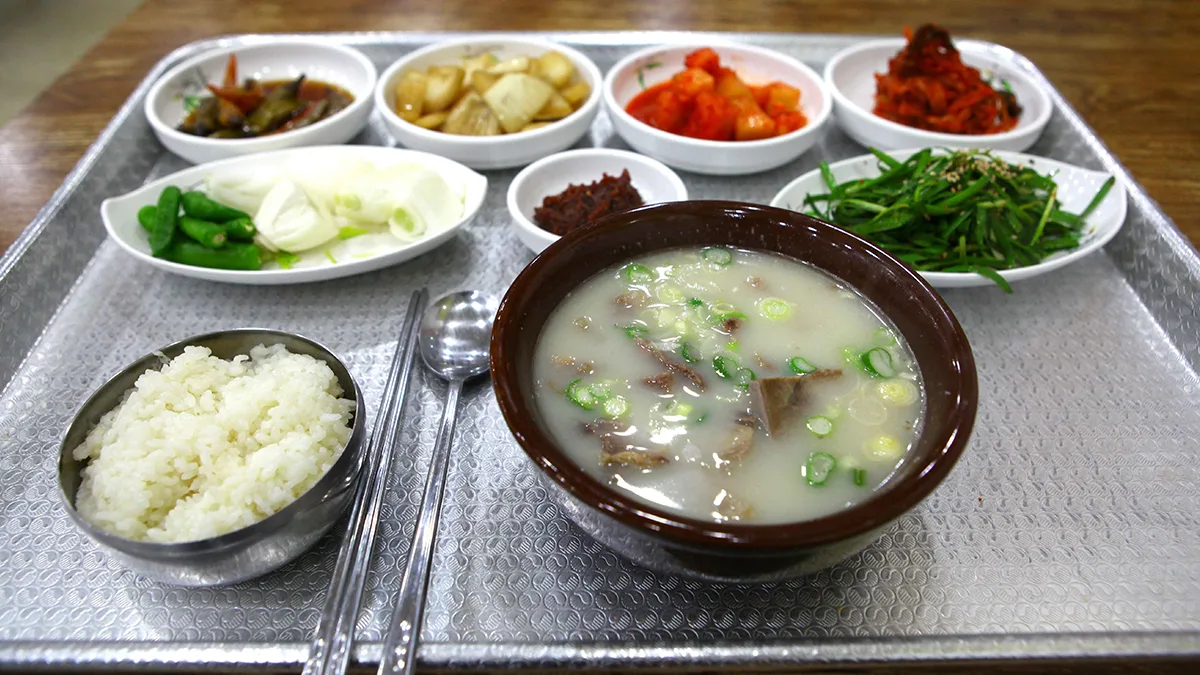No products in the cart.
Sogogi Someri Gomtang || Beef Head Soup, 소머리곰탕 1
Sogogi Someri Gomtang, often simply referred to as Someri Gomtang, is a hearty and flavorful Korean beef bone soup. The name literally translates to “beef head soup,” as it’s primarily made by slowly simmering various parts of the cow’s head, including the meat, bones, and sometimes other connective tissues, for many hours, often over an entire day. This extended cooking process extracts the rich flavors and collagen from the bones and meat, resulting in a thick, milky-white broth.
Essential Ingredients:
- Beef head (1.5-2kg): Cleaned and prepared. You might need to ask your butcher to prepare this for you.
- Beef leg bones (ox bones/사골 – Sagol) (1kg): The more bones, the richer the broth.
- Water: Enough to cover the ingredients generously.
- Large green onions (2-3 stalks)
- Onions (1-2 medium)
- Garlic (1 head)
- Ginger (thumb-sized piece)
- Soju (Korean distilled spirit) (1/2 cup): For removing any remaining odors.
- Salt and pepper: To taste
Optional Ingredients:
- Korean radish (무 – Mu) (1/2): Adds a refreshing note.
- Whole black peppercorns (1 tbsp)
- Bay leaves (2-3)
Instructions:
- Soaking the Beef Head: Submerge the beef head in cold water to draw out the blood. This is crucial for eliminating any gamey odor. Soak for at least 3 hours, preferably overnight, changing the water 2-3 times.
- Blanching the Beef Head: In a large pot, bring water to a boil with the soju. Add the soaked beef head and blanch for about 5 minutes. This further removes impurities. Rinse the blanched beef head thoroughly under cold water.
- First Broth (1st Simmer): Place the blanched beef head and leg bones in a large pot. Add enough water to cover them completely. Add the green onions, onions, garlic, ginger, black peppercorns, and bay leaves (if using). Bring to a boil over high heat, then reduce to a simmer and cook for 2-3 hours, skimming off any foam or scum that rises to the surface. This is very important for a clean-tasting broth.
- Strain the First Broth: Strain the first broth through a fine-mesh sieve or cheesecloth, reserving the liquid. Separate the meat from the beef head and cut it into bite-sized pieces. Set aside.
- Second Broth (2nd Simmer): Return the leg bones to the pot and add the reserved first broth. Add more water if needed to cover the bones. Simmer for another 2-3 hours.
- Third Broth (Optional): For an even richer broth, strain the second broth and repeat the simmering process with fresh water for another 2-3 hours. Usually, two or three simmers are sufficient.
- Combine the Broths: Combine all the strained broths.
- Final Simmer: Return the combined broths to the pot and bring to a simmer. Add the reserved beef head meat and cook together for about 30 minutes to allow the flavors to meld.
- Seasoning: Season with salt and pepper to taste.
- Serving: Serve hot with rice. Garnish with chopped green onions.
Tips for Success:
- Thorough Soaking: Don’t rush the soaking process. This is the key to removing impurities and achieving a clean-tasting broth.
- Skimming: Be diligent about skimming off the foam and scum during the simmering process.
- Simmering Time: The simmering time may vary depending on your stove and the size of the bones. The broth should be milky white and flavorful.
- Using a Pressure Cooker: A pressure cooker can significantly reduce the cooking time. Follow your pressure cooker’s instructions for bone broth.
- Storage: Leftover broth can be stored in the refrigerator for several days or frozen for later use.
How to Enjoy Someri Gomtang:
- Serve with kkakdugi (깍두기, radish kimchi) or other Korean side dishes.
- You can add seasoned chili oil (다진 양념 – Dajin Yangnyeom, a mix of minced garlic, chili flakes, and other seasonings) to the soup for extra flavor.

This image is created using data from the Korea Tourism Organization's Photo Korea, which is open under the Public Domain License. You can download these images for free from phoko.visitkorea.or.kr. (본 이미지는 공공누리 제1유형으로 개방한 ‘한국관광공사 포토코리아'의 데이터를 이용하였으며, 해당 저작물은 ‘phoko.visitkorea.or.kr’에서 무료로 다운받으실 수 있습니다.)





















































https://namu.wiki/w/%EC%86%8C%EB%A8%B8%EB%A6%AC%EA%B5%AD%EB%B0%A5